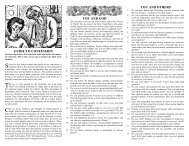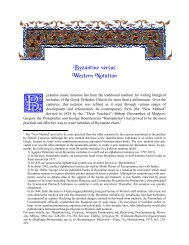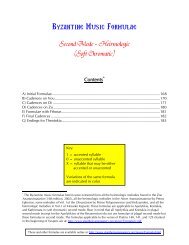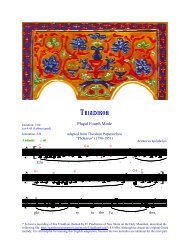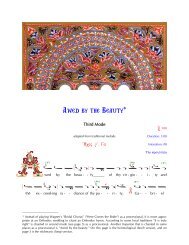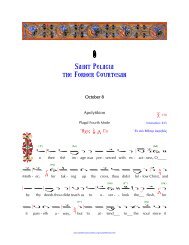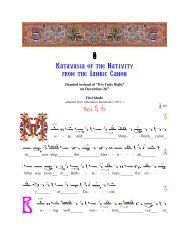Reading Psalmodia (PDF) - St. Anthony's Monastery
Reading Psalmodia (PDF) - St. Anthony's Monastery
Reading Psalmodia (PDF) - St. Anthony's Monastery
Create successful ePaper yourself
Turn your PDF publications into a flip-book with our unique Google optimized e-Paper software.
13. PITCH.Modern Psaltai tend to regard the pitch of the written notes as entirely relative. Thenineteenth century Patriarchal authorities, on the other hand, attempted to fix the pitchof the written notes in relation to a precisely defined pitch for Ni. In effect, they definedthe Ni of Tone Eight as slightly flatter than the C of Concert Pitch. This attempt at exactdefinition was part and parcel of an international nineteenth century culture ofnumerical precision: just as the pitch of Ni was precisely defined in terms of vibrationsper second, precise (but not always the same precise) definitions were offered of themicrotonal intervals both of the two chromatic scales and of the intervals produced bythe effect of accidentals. Eventually a monstrous instrument was invented to play all thepossible notes of psaltic music – something stringed instruments can do perfectly well.In practice, there is no possibility of giving an exact pitch to Ni or Pa as a means ofdefining the exact pitch of every note of every mode. Firstly, Psaltai have different voiceswith different ranges, and pitch the music differently in order to sing it well andreverently. Secondly, the priest and the deacon have also voices with a particular rangethat leads them to prefer to sing their own parts of the service at a particular pitch.Indeed, considerations of vocal range can lead to conflict between clergy and singers asto the pitch at which a service should be sung. On the whole, peace seems to be attainedmost easily if the priest makes clear the note on which he prefers to chant, and theProtopsaltes organises the <strong>Psalmodia</strong> in such a way as to accommodate him. (This maymean singing at a higher or lower pitch than he would otherwise prefer, or, in extreme cases,where, for example, the priest sings Ni=G or Ni=F, by basing the <strong>Psalmodia</strong> on the tetrachordbelow the base note of the mode or on the upper tetrachord of the modal scale - e.g. singing ToneVIII based on the G below Ni or on the G above, or in the case of Tone I, basing the scale on theKe below Pa or basing the melodies in the tetrachord on the Di above. &c.)If both clergy and Psaltai have a good vocal range, then a pitch can be chosen thatapproximates to that officially laid down by the Patriarchal Epitropoi, i.e., the Ni of ToneVIII can be pitched somewhere between B flat and C.During a service it is not appropriate for the tuning of the <strong>Psalmodia</strong> to be shifted,unless it is absolutely essential. Where such changes occur they should reflect thestructural divisions of the Liturgy.In an extreme case it is possible for priest and psaltes, or even for protopsaltes andlampadarios, to sing at different pitches, the result is bizarre and undesirable butperhaps better than a diet of screeching and groaning.MODULATION from TONE to TONE:Within a single service, and sometimes even within a single piece, the chant will moveamongst the different Tones, and from one mode to another within a single Tone.Normally the modulation is accomplished without transposition of pitch. In the case ofthe diatonic modes this is easy to understand: the Pa of Tone I becomes the Pa of ToneVII or of Tone V, the Vu of Tone IV becomes the Vu of Tone I or of Tone VIII. TheEnharmonic and Chromatic modes require more careful attention: modulation without





